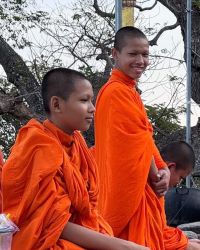According to a Khmer legend, their people came into being from a marital union between an Indian Brahmin priest named Kaundinya I and Princess Soma from Nagaland. Archeologists and linguists believe they arrived in what is now Cambodia about 4,000 years ago, bringing rice cultivation with them. This was one of the first places where they used bronze tools.
The great Khmer Empire, which flourished between the ninth and thirteenth centuries, encompassed present-day Thailand, Cambodia, Laos, and southern Vietnam. Its power declined when the Thai and Vietnamese conquered the Khmer and restricted them to the area that now known as Cambodia.
The Central Khmer have virtually been absorbed into the Vietnamese community, though many still speak Khmer at home. They have intermarried and now share the same religions, customs, and culture. Most of the Khmer are farmers who grow rice in irrigated paddies. They live in thatch roof, bamboo houses that are built on stilts.
Fish and shellfish from the coastal waters and the plains of the Mekong River are a major resource for the Khmer. It is also the second most important staple food, after rice. Forestry was once a major industry in the area inhabited by the Khmer. However, most of the timber has now been used for reconstruction after the wars in the 1970s.
The Khmer have a simple social structure. Each village has its own chief, and there is no political structure beyond the village. The village chief is the link between the people and the central government. Village leadership is usually divided; the chief has authority in secular matters, while the Buddhist monk has authority in religious issues. The Buddhist Wat, or temple, is the center of village life, and Buddhist rules of conduct are used to maintain social control. These rules of conduct include abstaining from lying, stealing, drinking alcoholic beverages, committing adultery, and killing living creatures.
Central Khmer are Buddhist, although relics of ethnic religions such as ancestor worship (praying to deceased ancestors) and spirit worship are very real.
The Hemshin people in Kyrgyzstan presently make up diverse groups of Sunni Muslims. The vast majority follow Sunni Islam. Their practices align with the Hanafi school, which dominates the region. These people depend upon good works and obedience to the ways of Islam to pay the penalty for their sins. They believe that Allah spoke through his prophet, Mohammed, and taught mankind how to live a righteous life through the Koran and the Hadith. However, the Hanafi school teaches flexibility and the use of reason in interpreting Islamic law. Its wide following shapes the Hemshin's local religious practices and legal traditions.
Full Bible resources exist in the Turkish and Armenian languages. Workers who appreciate their historical identity and traditions could become Christ's ambassadors to the Hemshins.
Pray for an abundant blessing of Khmer families and communities in Vietnam as they embrace Jesus Christ, the Lord of Lords.
Pray for a movement to Christ that will enrich the Khmer community in Vietnam.
Pray for spiritual openness to Jesus Christ that the belief will not hinder in religious institutions rather than the person, Jesus Christ.
Scripture Prayers for the Khmer in Vietnam.
Peoples of Vietnam, Asia Harvest, Copyrighted © Used with permission.
| Profile Source: Joshua Project |

























